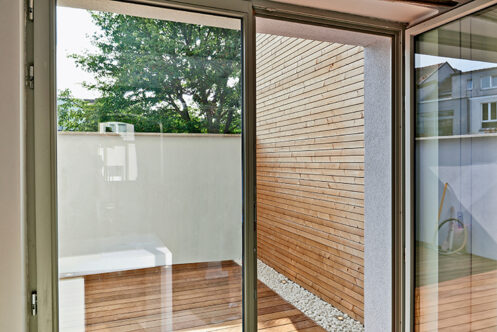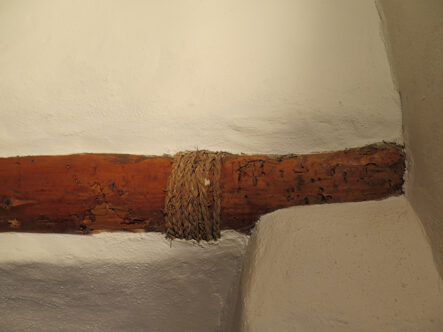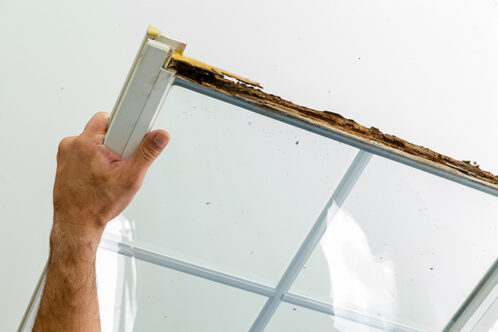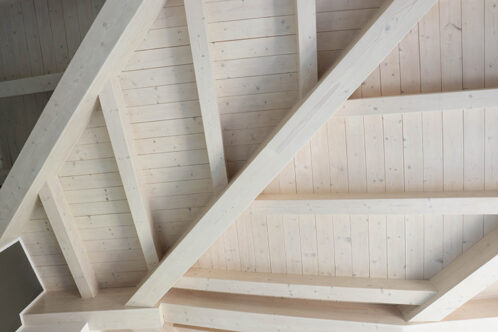Wood plays a big role in home design. You can find it in a home’s foundations as well as with garden sheds and fences. Preserving wood is the secret to avoiding a rotting home. It’s a natural product so it will be affected by moisture changes. While new-build homes should be constructed with timber preservation in place, we’re not all fortunate enough to build our homes from scratch or have a modern home and because of this, a timber problem may arise. Do you know what to look out for and how to deal with the fallout from less than perfect timber?

What can happen?
Problems arise because moisture has come into contact with the wood. Wet rot and dry rot are both caused by damp timber – a 20% moisture level for dry rot and 28-30% moisture level for wet rot. Once you have a problem, you only need a 20% level for both problems to stick around and a nice patch of damp wood in a humid home is the perfect home for common woodworms or beetle larvae that love to breed within the wood before making a 1.5-2mm hole from which they escape.

Dry rot
Dry rot is caused by the Serpula Lacrymans fungus breaking down wood cellulose, which causes the timber to become dry. The fungi grows and effectively eats the timber until it “fruits” and reproduces more fungal spores for the process to start again. It’s tricky to spot because the timber won’t feel damp to the touch but you may spot a white growth over the timber which will emit the dark red spore dust. You can purchase sensors such as Fugenex for under £10 to be sure. Drill a small hole into the wood and watch to see if the sensor changes colour. If it does, you’ve got a problem that needs addressing.
Wet rot
Wet rot is caused by multiple fungi and may or may not feel damp depending on if your timber’s painted. If it doesn’t feel wet, try to push a knife into it. Rotting timber will feel spongy and look darker than the wood that surrounds it. It’s difficult to push a knife into healthy wood.

Woodworm
Holes in the wood are indications that you’ve had woodworm but that doesn’t mean that you still have an issue. Check for dust around the holes, as this is a tell-tale sign that the critters have bored recently and are very much alive. If you’re unsure, scrape off a layer of wood and look for moving larvae.
How to rescue your home
No matter which treatment you try, it won’t last for long unless you identify and banish the source of the damp. A leaking roof, overflowing pipe or a badly sealed bath are all common causes, so make sure that the room is well-ventilated and hire in a tradesperson to help you fix the problem or indulge in a spot of DIY if the remedy is something that you can legally and confidently perform. If you’re not sure what’s causing your damp, hire in a specialist tradesperson to investigate!
Depending on how serious the rotting problem is, you’ll either need to apply a chemical treatment or replace the wood completely with a pre-treated wood to guard against future attacks. Finishes containing fungicide such as zinc oxychloride are often used to form a barrier around the timber, to prevent moisture from passing through and damaging the wood but you may find that a different treatment would work best for you.

Wood can be shut off from moisture by physical barriers such as masonry sterilisation as well as by inserting water-soluble borate rods into the timber itself. Unless you’re skilled in the art of timber preservation and rot, you’ll need to bring in a tradesperson to help, or else you could waste both time and money on a treatment that won’t do its job. Water-soluble borate rods are great for preventing rot but they won’t work on a damp problem that’s progressed to an advanced stage.
The same approach goes for live woodworm. There are different types of woodworm, so you’ll need to identify which type you have before you attempt to treat the problem. On average, you can expect to pay between £500-£1000 to treat an average 4-bed home but lighter infestations that only affect a small area can be treated for around £28 per 25 square metres. If there’s no sign of live woodworm and you’re certain that the holes in wood are the mark of an old problem, varnish or paint the wood to stop them from returning and boring through and ventilate your home as much as possible to keep the humidity level low.
To find a timber preservation, woodworm and rot specialist, post your job under our Specialist Tradespeople category. Our tradespeople will get in touch with you to quote and you’ll be able to view their profile pages, complete with ratings, to help you decide who to hire.




I have woodworm in my living room but St seems to be in the wooden floor and not the floor boards as we have took some of the floor up ! Would it be best to take the wood floor up all together or is there another way to treat it !
Hi Pauline,
Oh dear! Our tradespeople are best off answering that one for you. If you like, you can post this as a question in our Ask an expert forum (https://www.ratedpeople.com/diy-advice/).
Thanks,
Natalie
Wow, I liked that you explained that there are chemical treatments to help you stop the rotting and help dry out the wood. I have been wanting to use a few old pieces of my grandfather’s barn in my garden. It seems like ti would be smart for me to try to treat the wood so it doesn’t rot. http://www.jensenretainingwalls.com/landscaping